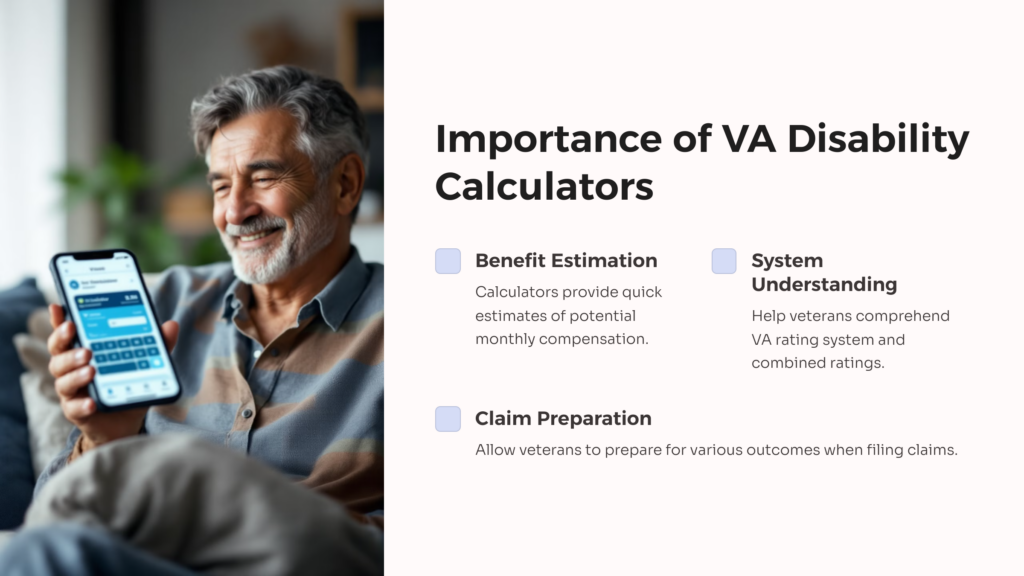Understanding VA Disability Ratings
Veterans who have served our country often face challenges related to disabilities acquired during their service. The Department of Veterans Affairs (VA) provides disability compensation to eligible veterans, but understanding how these benefits are calculated can be confusing. This is where a VA disability calculator comes in handy.
A VA disability calculator is a tool that helps veterans estimate their potential disability compensation based on their specific conditions and ratings. It’s important to note that while these calculators can provide a good estimate, the final determination of benefits is made by the VA.
The VA uses a percentage-based system to rate disabilities. These ratings range from 0% to 100%, with higher percentages indicating more severe disabilities. A 0% rating means the condition exists but doesn’t significantly impact the veteran’s ability to function, while a 100% rating suggests a severe disability that greatly affects the veteran’s life.
How VA Disability Ratings Are Determined

The VA determines disability ratings based on the severity of a veteran’s service-connected conditions. This process involves several steps:
- Filing a claim: Veterans must first file a claim with the VA, providing evidence of their disability and its connection to their military service.
- Medical evaluation: The VA may require a Compensation and Pension (C&P) exam to assess the severity of the claimed conditions.
- Evidence review: VA claims processors review all available evidence, including service records, medical reports, and the C&P exam results.
- Rating assignment: Based on the evidence, the VA assigns a percentage rating for each service-connected disability.
It’s crucial to understand that the VA uses a specific formula to calculate the overall disability rating when a veteran has multiple service-connected conditions. This formula is not a simple addition of individual ratings but a more complex calculation that accounts for the combined impact of multiple disabilities.
The Importance of VA Disability Calculators

VA disability calculators play a vital role in helping veterans understand their potential benefits. Here’s why they’re important:
- Estimation of benefits: Calculators provide a quick estimate of potential monthly compensation, helping veterans plan their finances.
- Understanding the rating system: Using a calculator can help veterans better understand how the VA rates disabilities and combines multiple ratings.
- Preparation for claims: By inputting different scenarios, veterans can prepare for various outcomes when filing or appealing claims.
- Resource allocation: Veterans can use calculators to determine if seeking an increase in their disability rating might be beneficial.
While VA disability calculators are useful tools, it’s important to remember that they provide estimates, not guaranteed amounts. The VA’s final determination may differ based on factors not accounted for in most online calculators.
How to Use a VA Disability Calculator
Using a VA disability calculator is typically a straightforward process. Here’s a general guide:
- Find a reputable calculator: Look for calculators on trusted veteran-focused websites or VA-affiliated resources.
- Input your information: Enter details such as your current disability ratings for each condition.
- Add dependents: If applicable, include information about your spouse, children, or dependent parents.
- Review the results: The calculator will provide an estimate of your monthly compensation based on the information provided.
- Explore different scenarios: Try inputting different ratings to see how changes might affect your benefits.
Remember, these calculators are meant to provide estimates. For the most accurate information about your specific case, always consult with the VA or a Veterans Service Organization (VSO).
Common Factors That Affect VA Disability Ratings
Several factors can influence your VA disability rating and, consequently, your compensation. Understanding these can help you use a VA disability calculator more effectively:
- Severity of the condition: More severe disabilities generally receive higher ratings.
- Multiple disabilities: The VA uses a combined ratings table for veterans with multiple service-connected conditions.
- Secondary conditions: Disabilities that develop as a result of a service-connected condition can also be rated and included in your overall disability picture.
- Unemployability: Veterans who can’t work due to service-connected disabilities may qualify for Total Disability Individual Unemployability (TDIU), which pays at the 100% rate regardless of their combined rating.
- Temporary ratings: Some conditions may receive temporary 100% ratings during active phases or recovery periods.
By considering these factors when using a VA disability calculator, you can get a more accurate estimate of your potential benefits.
Limitations of VA Disability Calculators

While VA disability calculators are useful tools, they do have limitations that veterans should be aware of:
- Simplified calculations: Most calculators use a simplified version of the VA’s combined ratings table, which may not account for all nuances in the official calculation.
- Individual circumstances: Calculators can’t account for unique individual circumstances that the VA might consider in their final determination.
- Potential errors: As with any online tool, there’s always a possibility of technical errors or outdated information.
- Lack of legal interpretation: Calculators can’t provide the kind of nuanced legal interpretation that might be necessary for complex cases.
- Changes in VA policies: VA policies and rating criteria can change, and online calculators may not always reflect the most current regulations.
Because of these limitations, it’s crucial to use VA disability calculators as a general guide rather than a definitive source of information about your benefits.
Benefits of Accurate VA Disability Ratings
Understanding and accurately calculating your VA disability rating can have significant benefits:
- Financial planning: Knowing your potential compensation can help you better plan your finances and budget effectively.
- Access to additional benefits: Higher disability ratings may qualify you for additional VA benefits, such as healthcare, education assistance, or housing grants.
- Employment support: Certain disability ratings may make you eligible for vocational rehabilitation and employment services.
- State and local benefits: Some states and localities offer additional benefits to disabled veterans based on their VA disability ratings.
- Peace of mind: Having a clear understanding of your benefits can reduce stress and uncertainty about your financial future.
By using a VA disability calculator in conjunction with official VA resources and professional assistance, you can ensure you’re receiving all the benefits you’ve earned through your service.
Seeking Professional Assistance
While VA disability calculators are valuable tools, they shouldn’t replace professional assistance. Here are some resources that can provide more personalized help:
- Veterans Service Organizations (VSOs): Many organizations offer free assistance with VA claims and appeals.
- VA-accredited attorneys: Lawyers specializing in veterans’ law can provide legal advice and representation.
- VA regional offices: Local VA offices can provide information and assistance with claims.
- Vet Centers: These community-based counseling centers can offer guidance and support.
Remember, the goal is to ensure you receive all the benefits you’re entitled to for your service and sacrifice. Don’t hesitate to seek help if you’re unsure about any aspect of your VA disability claim or rating.
VA disability calculators are invaluable tools for veterans navigating the complex world of disability benefits. They provide quick estimates, help in understanding the rating system, and assist in financial planning. However, they should be used as part of a broader strategy that includes official VA resources and professional assistance.
By combining the insights gained from VA disability calculators with expert guidance, veterans can ensure they’re making informed decisions about their benefits. Remember, the goal is not just to understand your current benefits, but to advocate for the full range of support you’ve earned through your service to our nation.
 AllVeteran.com Advisors
AllVeteran.com Advisors
With expertise spanning local, state, and federal benefit programs, our team is dedicated to guiding individuals towards the perfect program tailored to their unique circumstances.


















